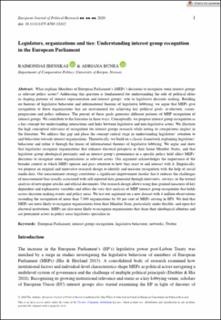Legislators, organizations and ties: understanding interest group recognition in the European Parliament
Journal article, Peer reviewed
Published version

Åpne
Permanent lenke
https://hdl.handle.net/11250/2739079Utgivelsesdato
2020Metadata
Vis full innførselSamlinger
Originalversjon
European Journal of Political Research. 2020 https://doi.org/10.1111/1475-6765.12412Sammendrag
What explains Members of European Parliament's (MEPs’) decisions to recognize some interest groups as relevant policy actors? Addressing this question is fundamental for understanding the role of political elites in shaping patterns of interest representation and interest groups’ role in legislative decision making. Building on theories of legislative behaviour and informational theories of legislative lobbying, we argue that MEPs give recognition to those organizations that are instrumental for achieving key political goals: re‐election, career‐progression and policy influence. The pursuit of these goals generates different patterns of MEP recognition of interest groups. We contribute to the literature in three ways. Conceptually, we propose interest group recognition as a key concept for understanding interactions and links between legislative and non‐legislative actors. We illustrate the high conceptual relevance of recognition for interest groups research while noting its conspicuous neglect in the literature. We address this gap and place the concept central stage in understanding legislators’ attention to and behaviour towards interest organizations. Theoretically, we build on a classic framework explaining legislators’ behaviour and refine it through the lenses of informational theories of legislative lobbying. We argue and show that legislators recognize organizations that enhance electoral prospects in their home Member States, and that legislator–group ideological proximity and an interest group's prominence in a specific policy field affect MEPs’ decisions to recognize some organizations as relevant actors. Our argument acknowledges the importance of the broader context in which MEPs operate and pays attention to how they react to and interact with it. Empirically, we propose an original and innovative research design to identify and measure recognition with the help of social media data. Our measurement strategy constitutes a significant improvement insofar that it reduces the challenges of measurement bias usually associated with self‐reported data generated through interviews, surveys, or the textual analysis of newspaper articles and official documents. Our research design allows using fine‐grained measures of key dependent and explanatory variables and offers the very first analysis of MEP interest group recognition that holds across decision‐making events and policy areas. We test our argument on a new dataset with 4 million observations recording the recognition of more than 7,000 organizations by 80 per cent of MEPs serving in EP8. We find that MEPs are more likely to recognize organizations from their Member State, particularly under flexible‐ and open‐list electoral institutions. MEPs are also more likely to recognize organizations that share their ideological affinities and are prominent actors in policy areas legislators specialize in.
